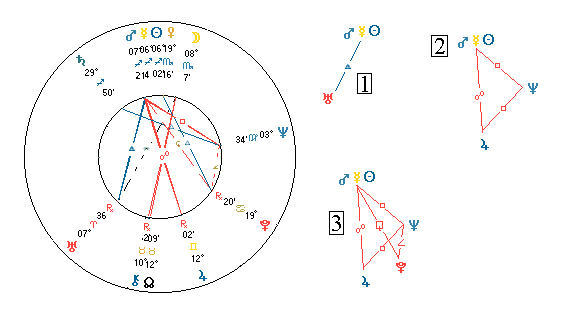
aspects are based on dividing the circle of the chart by whole numbers. If we start by dividing by one
we have the Conjunction, which appears in all "families" of aspects. If we divide by 2 we get the Opposition, by
4, we have the Square and by 8 we have the Sesquisquare or Sesquiquadrate. These are a very obvious family of aspects
based on the '2' series of number and we can continue this and look at the Semi-Octile, which is 22.5 degrees and 1/16th
of a circle.
It is important to look for patterns of aspects, known in astrology as configurations.
Illustrated here is the well-known T-Square, which becomes a Grand Cross
if a fourth planet is added at point 'A'. The importance of respecting the power of semisquares and sesquisquares
cannot be overstated however, even if a pattern, such as that illustrated right, is harder to pick out since there
is only one blindingly obvious square involved and angles of 45 and 135 degrees only become obvious when you
practise looking for them.
Close aspects are more powerful and if the pattern on the right had angles that were exact to within a degree,
while the T-Square had inexact squares and oppositions and no midpoint patterns pulled in, I would consider the harder
to see pattern as more powerful. I look for very close to exact Semi-Octile aspects in charts as these also have
a lot of potency.

Above are the so-called easy aspects, the Sextile and Trine which are said to confer talents which may be wasted,
since they come easily (hence the name of these aspects). Also shown, from second left are the Grand Trine, the Kite and
the Easy Opposition. Note how an Easy Opposition is a part of a Kite. In a Kite the focal opposition is huge factor
in interpretation, since it provides the stress for the talented, but often apathetic trines to act.
Other aspects include the Quintile, which is a fifth of a circle and the Septile, which is a seventh of a circle.
Aspect patterns can also be explored using harmonic charts. The subject is a vast one and goes hand-in-hand
with the development of a knowledge of planetary combinations. For example, a conjunction of Mercury and the Sun is very different
to a conjunction of Saturn and Neptune.
Analysis

Berry Gordy's chart has some powerful aspect patterns.
Most obvious is the triple conjunction of the Sun, Mercury and Mars in Sagittarius (fig 1). This alone invites many
interpretations; a man with a drive (Mars, Sun) to do deals (Mercury); someone who tends to be argumentative (Mars, Mercury);
someone with a great deal of energy (Mars) to do many things (Mercury) and so on. Being a conjunction involving the Sun, this
part of the chart is absolutely central to our consideration.
The trine to Uranus shows that he is at ease with new things, technology, the cutting edge. He is quick in his actions
(Mars trine Uranus), sharp-minded and given to novel solutions (Mercury trine Uranus) and someone who finds personal
originality easy (Sun trine Uranus).
The Sun is also involved in a T-Square (fig. 2) with Neptune (to which it is square by 2-3 degrees) and Jupiter (an opposition
of 5.5-6.5 degrees). While this is not as exact as the aspects in the first configuration, it is clearly easily close enough
and involves the only earth placed planet, Neptune, as a focus of two squares.
Here we see that Gordy is challenged (2 and 4 series aspects) to work with big (Jupiter) collective dreams
and/or illusions (Neptune). Furthermore in Fig 3 we see that his Sun-Mercury-Mars is also linked by sesquisquare to Pluto
very strongly (the aspect to the Sun was exact to less than 2 degrees the whole of his day of birth). This
shows that Gordy's central life purpose (the Sun) is linked to all three of the outer planets (Uranus Neptune and
Pluto). Crucially it is also wedded to the historic long-term underlying cultural cycle of Neptune-Pluto in the particular aspect it
was making at his birth (a waxing semisquare). Such forces, particularly the hard aspects from Neptune and Pluto
to the Sun can be overwhelming for many, but Gordy's will
and integrity (not illustrated in a chart! - though perhaps bolstered by the strength of fire and Sun conjunct Mars) have
made him able to play his part in the unfolding of deeper transformations through his work with Motown.
continue reading





